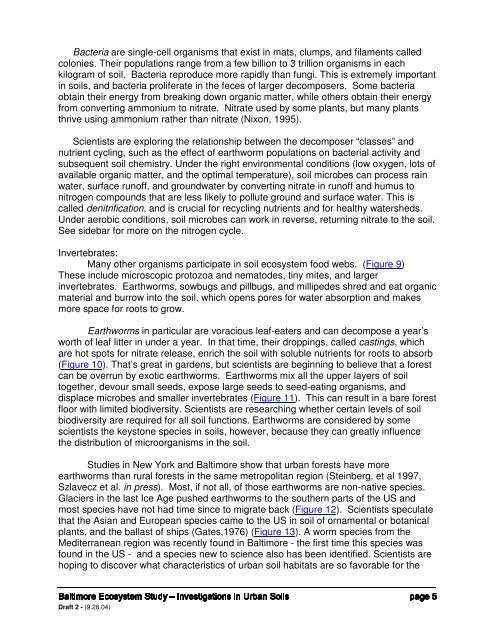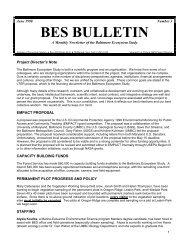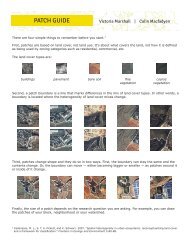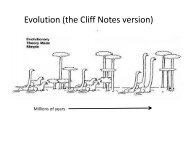Investigations in Urban Soils - Baltimore Ecosystem Study
Investigations in Urban Soils - Baltimore Ecosystem Study
Investigations in Urban Soils - Baltimore Ecosystem Study
Create successful ePaper yourself
Turn your PDF publications into a flip-book with our unique Google optimized e-Paper software.
Bacteria are s<strong>in</strong>gle-cell organisms that exist <strong>in</strong> mats, clumps, and filaments called<br />
colonies. Their populations range from a few billion to 3 trillion organisms <strong>in</strong> each<br />
kilogram of soil. Bacteria reproduce more rapidly than fungi. This is extremely important<br />
<strong>in</strong> soils, and bacteria proliferate <strong>in</strong> the feces of larger decomposers. Some bacteria<br />
obta<strong>in</strong> their energy from break<strong>in</strong>g down organic matter, while others obta<strong>in</strong> their energy<br />
from convert<strong>in</strong>g ammonium to nitrate. Nitrate used by some plants, but many plants<br />
thrive us<strong>in</strong>g ammonium rather than nitrate (Nixon, 1995).<br />
Scientists are explor<strong>in</strong>g the relationship between the decomposer “classes” and<br />
nutrient cycl<strong>in</strong>g, such as the effect of earthworm populations on bacterial activity and<br />
subsequent soil chemistry. Under the right environmental conditions (low oxygen, lots of<br />
available organic matter, and the optimal temperature), soil microbes can process ra<strong>in</strong><br />
water, surface runoff, and groundwater by convert<strong>in</strong>g nitrate <strong>in</strong> runoff and humus to<br />
nitrogen compounds that are less likely to pollute ground and surface water. This is<br />
called denitrification, and is crucial for recycl<strong>in</strong>g nutrients and for healthy watersheds.<br />
Under aerobic conditions, soil microbes can work <strong>in</strong> reverse, return<strong>in</strong>g nitrate to the soil.<br />
See sidebar for more on the nitrogen cycle.<br />
Invertebrates:<br />
Many other organisms participate <strong>in</strong> soil ecosystem food webs. (Figure 9)<br />
These <strong>in</strong>clude microscopic protozoa and nematodes, t<strong>in</strong>y mites, and larger<br />
<strong>in</strong>vertebrates. Earthworms, sowbugs and pillbugs, and millipedes shred and eat organic<br />
material and burrow <strong>in</strong>to the soil, which opens pores for water absorption and makes<br />
more space for roots to grow.<br />
Earthworms <strong>in</strong> particular are voracious leaf-eaters and can decompose a year’s<br />
worth of leaf litter <strong>in</strong> under a year. In that time, their dropp<strong>in</strong>gs, called cast<strong>in</strong>gs, which<br />
are hot spots for nitrate release, enrich the soil with soluble nutrients for roots to absorb<br />
(Figure 10). That’s great <strong>in</strong> gardens, but scientists are beg<strong>in</strong>n<strong>in</strong>g to believe that a forest<br />
can be overrun by exotic earthworms. Earthworms mix all the upper layers of soil<br />
together, devour small seeds, expose large seeds to seed-eat<strong>in</strong>g organisms, and<br />
displace microbes and smaller <strong>in</strong>vertebrates (Figure 11). This can result <strong>in</strong> a bare forest<br />
floor with limited biodiversity. Scientists are research<strong>in</strong>g whether certa<strong>in</strong> levels of soil<br />
biodiversity are required for all soil functions. Earthworms are considered by some<br />
scientists the keystone species <strong>in</strong> soils, however, because they can greatly <strong>in</strong>fluence<br />
the distribution of microorganisms <strong>in</strong> the soil.<br />
Studies <strong>in</strong> New York and <strong>Baltimore</strong> show that urban forests have more<br />
earthworms than rural forests <strong>in</strong> the same metropolitan region (Ste<strong>in</strong>berg, et al 1997,<br />
Szlavecz et al. <strong>in</strong> press). Most, if not all, of those earthworms are non-native species.<br />
Glaciers <strong>in</strong> the last Ice Age pushed earthworms to the southern parts of the US and<br />
most species have not had time s<strong>in</strong>ce to migrate back (Figure 12). Scientists speculate<br />
that the Asian and European species came to the US <strong>in</strong> soil of ornamental or botanical<br />
plants, and the ballast of ships (Gates,1976) (Figure 13). A worm species from the<br />
Mediterranean region was recently found <strong>in</strong> <strong>Baltimore</strong> - the first time this species was<br />
found <strong>in</strong> the US - and a species new to science also has been identified. Scientists are<br />
hop<strong>in</strong>g to discover what characteristics of urban soil habitats are so favorable for the<br />
Draft 2 - (9.28.04)<br />
<strong>Baltimore</strong> <strong>Ecosystem</strong> <strong>Study</strong> – <strong>Investigations</strong> <strong>in</strong> <strong>Urban</strong> <strong>Soils</strong><br />
page 5






